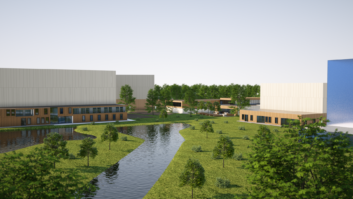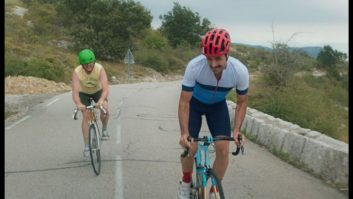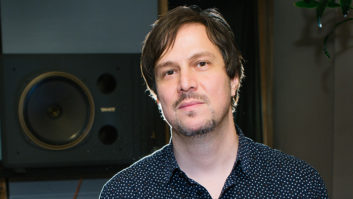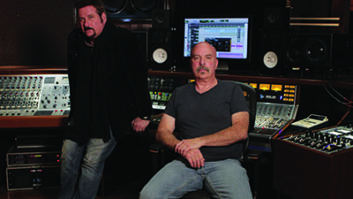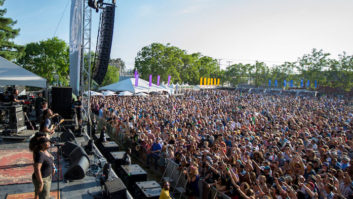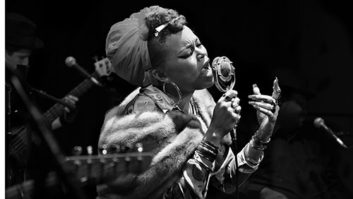It’s hard to mistake the beginning of a Lenny Kravitz show. First, there’s the afro-haired silhouettes as his four-piece band bounce to their spots onstage, quickly followed by a lighting “special” — a flurry of fake dollar bills imprinted with Kravitz’s face showers over the audience. Onstage, monitor engineer Mark Hughes’ vintage Conn Dynalevel SPL meter — a circa-1960 device that resembles an illuminated barber’s pole — begins to glow red. Within minutes, the sold-out crowd is on its feet, nodding and dancing to Kravitz’s trademark sound of crunching guitars, thundering bass runs and smacking drums.
The attitude and stage presence are all rock ‘n’ roll — sound levels in the house are appropriately loud. Yet, Kravitz’s show is controlled, punchy and tight, even at the Shoreline Amphitheater (Mountain View, Calif.), one of the San Francisco Bay Area’s several odd-sounding venues, where Mix attended a raucous show in late August. Kravitz is notoriously picky about his live sound. (He engineers his own albums and is a vintage-equipment enthusiast.) So, the fact that every solo, drum flourish, bass riff, backing vocal or brass stab is perfectly audible is by no means an accident. The Kravitz show is a finely tuned touring production that relies on quality components, an “old-school” analog signal chain and the talents of an experienced team of sound engineers.
ENDLESS REHEARSALS
Preparation for the Lenny Live world tour, Kravitz’s first in three years, began this past January when rehearsals started in Florida. New at FOH was veteran mixer Dave Natale, longtime engineer for Tina Turner (see Mix, August 1997 for a show report) and most recently out with Lionel Richie. “When they were looking for a sound guy, I guess they called all of the sound companies,” recalled Natale. “They said, ‘Put three names on a piece of paper of who you think we should have mix this tour.’ I guess my name came up the most.”
In fact, Natale has known production manager Chris “Napalm” Adamson for more than a decade and worked with him closely to fine-tune the sound system’s specs. Working from a previous rider, sound system contractor Sound Image (Escondido, Calif.) provided two Midas consoles for FOH and an extensive complement of outboard gear. With Adamson’s encouragement, Natale drastically reduced the amount of FOH gear and, by rationalizing the input list, was able to fit everything on a single Yamaha PM4000 console configured with 40 mono and 12 stereo channels.
“I like the Midas XL4, but it’s got a computer in it,” explains Natale. “If it decides it’s not going to work, that’s it; it’s not going to work. If it didn’t have the computer, I’d use it. On the other hand, the Yamaha 4k has never broken on me since the second year it came out. I waited one or two years to see if they all blew up first and made sure that [Yamaha] got all of the bugs worked out, and I haven’t used anything else since. It works every day with absolutely no problems.”
With the benefit of more than two months of rehearsal (the tour, designed to promote Kravitz’s latest album, Lenny, finally kicked off at New York’s Hammer- stein Ballroom in early May), Natale had ample time to rehearse and perfect all of his console moves. “When I first interviewed for the gig, Lenny asked me if I knew all of the albums,” Natale recalls. “He wanted all of the effects and balances reproduced from the records, so I had to sit down and work out how to re-create all of the reverbs, delays and other studio sounds.”
For Kravitz’s vocal effects, Natale chose three Yamaha SPX-990s, one SPX-900 and a Motion Sound R3/147. One 990 is used as a straight reverb, and the other two are set for delays; the SPX 900 is used for distortion, and the Motion Sound unit is a Leslie speaker simulator. The rackmount unit actually contains a spinning speaker and multiple microphones. Another three SPX-990s provide band and drum reverbs, plus a slapback delay for drums.
Rather than bring the reverb returns up and down in the mix, Natale has all of the returns “on” all of the time and uses a Yamaha MPC1 MIDI program changer to cycle through the relevant programs. “I just hit ‘Up,’ ‘Up,’ ‘Down,’ ‘Next,’ ‘Next,’” says Natale. “Every song has a program number, so if an effect is not being used on the song, I have the output gain programmed to zero; that way, I don’t have to turn stuff up and down.” Natale uses much the same method for all 12 guitar inputs — Kravitz has five separate amp/speaker setups, and second guitarist Craig Ross has seven, which they switch among onstage. Because all of the cabinets are close-miked (with Audio-Technica 4050s), leakage into whichever mics are on “standby” is minimal, so Natale leaves all 12 channels active, goosing the active mics for solos as needed. He keeps track of solo and effects cues on a stack of 5×7 index cards, another retro touch.
LESS IS BEST
In line with his philosophy that simpler is better, Natale mixes direct to the main stereo bus, using the board’s VCA section for group trims. Because all of the inputs are in use, Natale routes the band reverb stereo returns to the PM4000’s subgroup section, using the remaining stereo subgroup as a premix of Kravitz’s effects returns for the monitor mix.
Apart from Kravitz’s vocal effects, Natale’s use of processing is relatively modest. A second FOH rack holds two Focusrite ISA 110s and a 2-channel Manley Electro-Optical Limiter for Kravitz’s lead and spare vocal mics, both Audio-Technica 4054s. The only other dynamic processors that Natale uses are a pair of dbx 160As for the bass DI and bass mic, and two Drawmer DS201 2-channel noise gates. Only three of the four gates are used: one for the kick and one each for rack and floor toms. In stark contrast to most FOH mixers’ effects racks, Natale’s two racks look mostly empty, with large areas taken up by blank panels. Though Sound Image also provided an HHB CD recorder/player and a Panasonic DAT machine, Natale hardly uses them. “I just have them in case, but no one in the band ever listens to the DATs of the shows, and we only use the CD player for walk-in music,” he notes.
The main P.A. for the tour is a JBL VerTec line array system. During final production rehearsals, Kravitz kept asking for more P.A., with the result that the tour’s system is one of the largest VerTec systems on tour — 48 VT4889 full-frequency cabinets and 32 VT4880 subwoofers. At Shoreline, the Sound Image crew flew two 15-cabinet arrays for the main L/R system, with 9-cabinet side arrays. The system is powered by 50 Crown Macrotech 5000 amps, while speaker-management functions are performed by five BSS 366 Omni Compact Pros and six BSS Varicurves.
“I love this system,” says Ted Bible, system engineer for Sound Image. “This is my fourth tour in a row working with VerTec, and I’m digging it. It’s loud — it moves a lot of air. It looks nice aesthetically, sight lines are great, coverage is great. It goes in and out of a truck wonderfully, stacks excellent. Straight across the board, it’s an easy system.”
IN-EARS PLUS SIDEFILLS
Onstage, monitor engineer Mark Hughes uses a Midas XL4 with an XL3 extender; like Natale, Hughes prefers to keep the signal flow short and easy to control, without the aid of a computer. “I prefer active mixing; it’s fun because it is precise,” Hughes says. For Kravitz’s vocal, Hughes uses an API mic pre and a Lucas tube compressor/tube EQ. Kravitz and band all wear Future Sonics in-ear monitors (IEMs) driven by either Shure PSM600 or Sennheiser 300 transmitters. To keep Kravitz’s in-ear mix consistent with Natale’s FOH mix, Hughes takes an effects submix from the FOH PM4000 and adds that mix into Kravitz’s IEMs after heavy protection limiting through a BSS DPR-404 4-channel compressor. Hughes also runs a set of sidefills to add low end to the stage.
“The in-ears are really good for the stage sound,” comments Natale. “As loud as Lenny plays, if he had to rely on wedge monitors up there, he wouldn’t sound nearly as good out front with all of the extra bleed going on.”
Though Kravitz sometimes jumps offstage to mingle with his fans, he prefers not to use a wireless mic, so his excursions into the audience are closely monitored by handlers and stage crew, who make sure his vocal mic and cable return to the stage in one piece. The rest of the stage miking setup is fairly straightforward. Drum mics include a Beyer M88 on kick, a Shure SM57 on the snare, AKG 414 on hi-hat, Beyer Opus 87s on toms and AKG 414s for overheads. The Leslie cabinet for the B3 is miked with a Sennheiser 421 on the bottom and two Audio-Technica 4051s on top while a wireless ATM 35 handles the occasional sax solo played by Harold Todd. Direct inputs include Kravitz’s and Ross’ acoustics, which are picked up through repurposed Helios console modules; the Wurlitzer that Ross plays on a few tunes, plus sampled kick and sampled snare inputs, are all captured via BSS DIs.
Though Kravitz’s tour schedules are always subject to last-minute changes, fans who catch him on the current outing are sure to hear such crowd-pleasers as “Are You Gonna Go My Way,” a fantastic remake of the Guess Who’s “American Woman” (from the soundtrack to Austin Powers: The Spy Who Shagged Me) and “Fly Away” performed with precision and enthusiasm. As monitor engineer Hughes puts it, “It’s nice to work for someone who gives sound priority.”
Sarah Benzuly is Mix’s associate editor.
